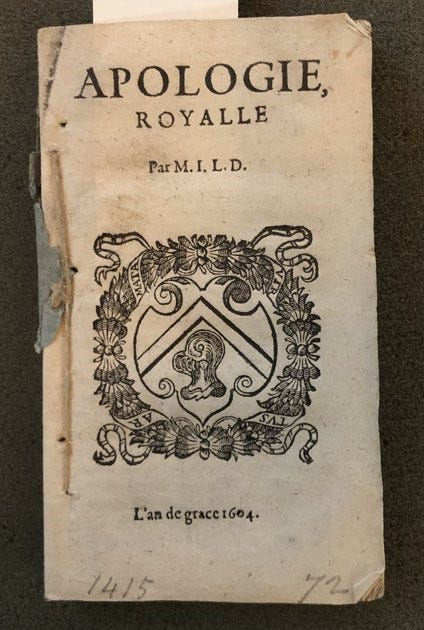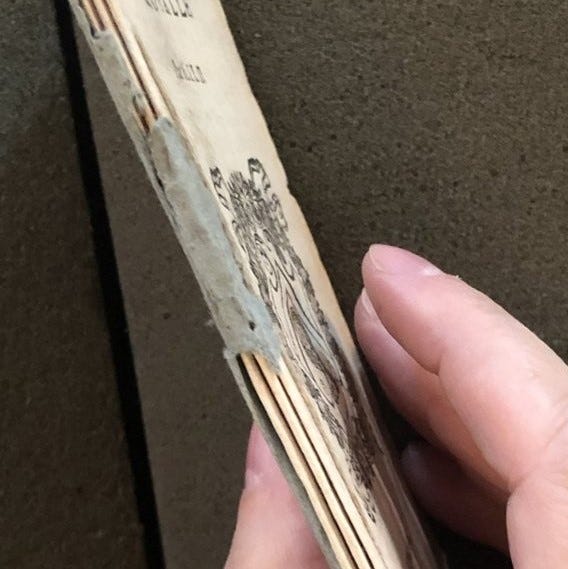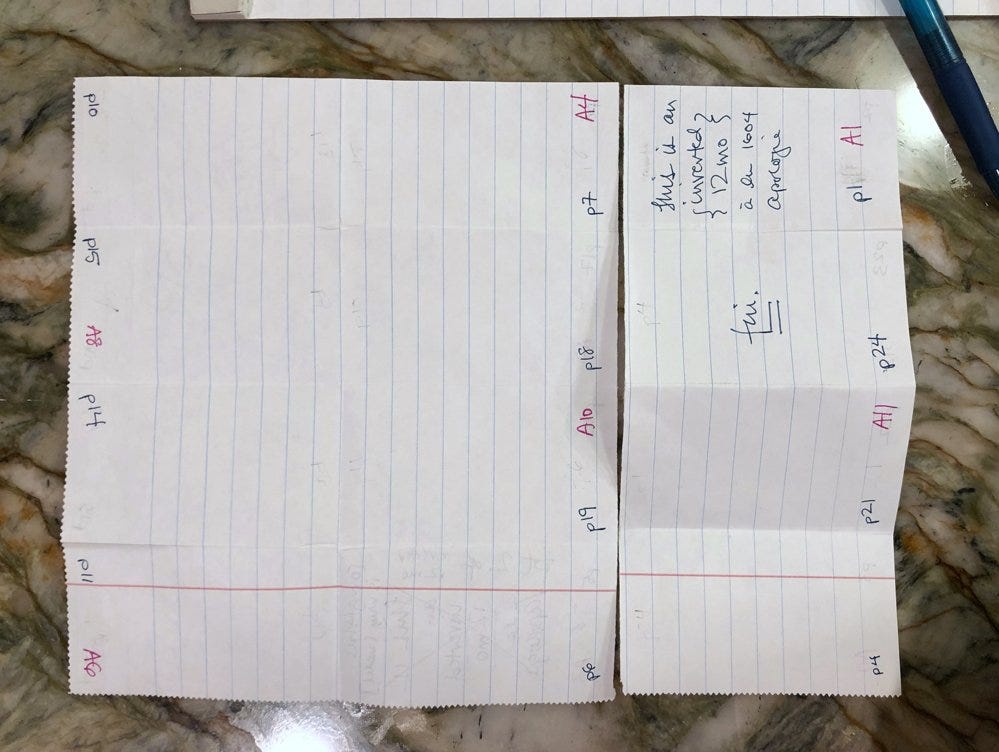I’m going to let you in on a secret: I find 12mos confusing. Duodecimos, to give the format its formal Latin name, have to be cut and folded in order to work, and to be even more honest, I can barely get my head around impositions that are just folding. This, for what it’s worth, is why I always always always recommend folding your own formats to understand their impositions. Some of us can hold shapes in space in our heads, and some of us need to hold those things in our hands to see them.
{A brief aside: If you aren’t already familiar with the basic concepts of format (the relationship between leaves and sheet) and imposition (how pages are laid out in a forme) then this newsletter is going to be confusing. I’m sorry. If you have my book at hand, go read through the section on format in Part 2, and then come back prepared to chuckle at this ridiculousness.}
A folio you fold widthwise once, and there you go! Fold it again and you’ve got a quarto. One more time, it’s an octavo; again, a sixteenmo. (I, like many other bibliographers, tend to switch from the latinate names to the anglicized ones right around duodecimo/twelvemo.)
With a 12mo, you need to cut off a strip in order to get twelve leaves in sequence. Here’s how Philip Gaskell shows the imposition of the inner forme of the common 12mo in his A New Introduction to Bibliography:

Again, it might be easier to grasp what’s happening if you literally grasp it: the strip of four is folded and inserted in the middle of the folded group of eight leaves—and four plus eight is twelve! You could, as you probably quickly saw, also add the group of four after the group of eight, but that’s a bit awkward, since there’s nothing actually holding the gathering together, and you’d have to be careful not to misplace the loose section when you were sewing. In that case, it’d be easier to think of that as a 12mo in 8s and 4s, with each section signed separately, the better to keep all the gatherings in the correct order.
But there’s another option, too, that I knew of from reading format diagrams but I hadn’t really thought about closely until I encountered this sweet little fellow at the Folger:

This little 12mo was printed in 1604. The first thing that makes it great is that it’s still partially in its original blue wrapper—you can see it just hanging on there under the stab stitching on the front and the full wrapper is present on the back. While it might be sad that the wrapper has been partially torn off, it also means that we can get a beautiful view from the spine of the three gatherings that make up this book:

I’m a sucker for books that show us their guts. The other thing that makes this book fun is that some of the pages are still unopened in the B and C gatherings. Here’s a look at the last four leaves in the B gathering showing what I mean: leaves B9 and 10 are conjugate (that is, connected as part of the same sheet) as are leaves B11 and B12.

You don’t see this too often because, of course, if someone were to actually have wanted to read the text on those leaves, they would have had to cut them open.
So here’s where I stumbled. I figured this was a 12mo because each gathering had 12 leaves and the chain lines ran horizontally. But how was it imposed so that the last four leaves would look like this? In the common 12mo imposition, leaves 7 and 8, 9 and 12 are joined at the fore-edge and 10 and 11 joined. (Wait, are you still not folding along? It’s so much easier to make sense of this with paper in hand.) If it was done as an 8 and 4, then you’d see 5:8, 6:7, and 11:12 joined at the fore-edge. (I’m ignoring the need to open the tops of the leaves in the 8-leaf section, but of course you can see from the diagram that they’re conjoined, too.) And remember the lovely clean spine and the clear bundles of three gatherings we saw? That definitely can’t happen with an 8-and-4.
So what is going on here? It’s an inverted 12mo, something that Gaskell describes that I hadn’t run across before when I was focusing on English books because it’s apparently a primarily Italian way of doing things. Here’s how it works:

Basically (because who can read diagrams, which is why you are folding this as you are reading, right??) the strip of four is folded in half and then wrapped around the group of eight.
That might sound pretty obvious, but this is how I worked out what the book was doing: I opened up Gaskell and looked at the various 12mo options he had: long, common, 8-and-4, and then I saw inverted. And…. well, to be honest, this is where things get fuzzy for me. I sat in the Folger reading room and saw a diagram that looked like it could work, tried to imagine it in my head, got a cold light to look for watermarks, and then said, “Aha!!” and went home happy. I think where past Sarah failed me is in not having had a piece of paper at hand to fold.
So just now, when I tried to confirm that by drawing a diagram for you all, I basically got myself all confused again and had to—yes, you guessed it—get a piece of paper out and fold it for myself. Since I keep harping on it, here’s how I go about creating paper models for myself to understand imposition. If I’m lucky to have a diagram that I suspect is of what I’m looking at, I start with folding a piece of paper along those lines, marking up both the signature marks and the page numbers. Here’s my attempt at Gaskell’s inverted 12mo, in which I’ve copied his numbers, split off the strip of four and then folded everything so the numbers lined up:

The next step is to adjust it to match what I’m seeing in an actual book-in-hand. In this case, I want to have the conjoined leaves at the end of the gathering, not the start, so I have to reverse how the strip of four is folded. So I refold and renumber:

Satisfied that it works, I then go over it with colored ink to differentiate between pagination and signature marks. I often bracket off the signed marks from the unsigned and when I’m being really careful about all this, I use a sheet on which I’ve drawn a watermark. I was not that obsessive this time. ¯\_(ツ)_/¯
But as you can see from this picture, my model does get the conjoined leaves at the end of the gathering, where they are in the Apologie’s B and C gatherings:

Cool! But do you see what problem still remains? In addition to 9:10 and 11:12 being conjugate, I have 7:8 joined as well. And they are clearly not in the book itself.
So what happened? How did both the B and C gatherings have 7:8 opened but not the other fore-edges? (All of the top conjugates are opened, but it seems less weird to me that those could have been split while the fore-edge left untouched.) If I start offering paid subscriptions to Early Printed Fun, paid subscribers would be able to leave comments on these letters, which could be fun. As it is now, you can maybe email me (sarah@earlyprintedbooks.com) with your thoughts or talk amongst yourselves.
Even though I haven’t solved this problem, I’m going to add my model of the inverted 12mo to my stack of paper models of impositions. I hope it encourages you not to be embarrassed by making your own models. Hands on learning is the best learning!
Some notes
When it came to think about what imposition schemes to include in my book, I went with as few as possible, on the principle that mine was a book for beginners and so I could just direct folks to Gaskell and his many diagrams. And so I went with the common 12mo and the 8-and-4. Alas, I am sorry now I didn’t include the inverted 12mo since I am obsessed with how tidy and fool-proof it is. (In the common imposition, you could mis-fold the strip of four pretty easily, or misplace it. But in the inverted, it wraps around the gathering and, it seems to me, has fewer opportunities for mis-folding.)
The other, more horrifying thing that I’m sorry about is that the diagram I included of the common 12mo is actually wrong. I mean, it’s wrong! In a published book! If you look up my diagram and compare it to Gaskell’s—or even just try to fold it as is—you’ll see that I swapped the 2nd and 4th leaves and the 9th and 11th leaves. It folds super awkwardly because of that, and I can’t imagine anyone would ever have printed that way. I don’t know why I made that mistake, but I can tell you what the problem is. A general rule of thumb is that if you hold a sheet with the first leaf down in the right-hand corner, you then want to fold the left side behind the right. The next step would be to fold the top down behind the bottom, and then left behind right again. I don’t know why, but I somehow folded it wrong and then even though I double-checked everything and had a couple of trusted bibliographer friends read the book, we all missed that. Format, I guess, is easy to gloss over until you need to look closely at it. Let that be a lesson to all of us. Also, let us remember that we all make mistakes and writing books is hard.
But this is why you are looking at Gaskell’s drawing of the inner form of the common and inverted 12mos rather than diagrams from my book. I guess I have another item to add to my errata list.
One last note: the book we’ve been looking at isn’t in the Folger’s online catalog, but the call number is DC122.9 B4 A7 Cage. Here’s a pretty picture of the card itself instead of a link:

I owe a big thanks to my friend Andras for calling this book to my attention many years ago. It really is a delightful object.
Thanks and see you soon!
I didn’t manage to hit my every-other-week goal with this letter. Maybe that’s too frequent of a schedule? I don’t think so—I just kind of ran into some personal exhaustion and a whole bunch of exciting ideas to write about that, part way through, had me realize I had to trudge back to the library to see books in person. Sorry for that. But at least now I know you’ll be so busy making paper models that you won’t even notice how long it’s been since the last installment!
In the meantime, mind your p’s and q’s—and your Gaskell!
Sarah.


